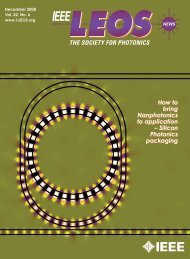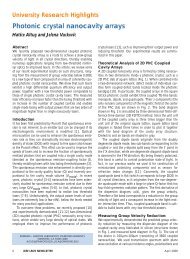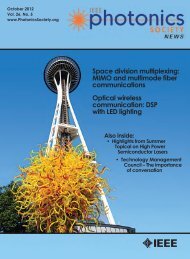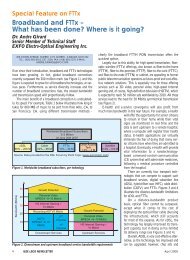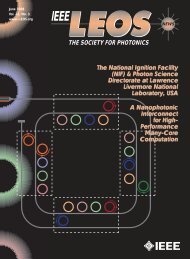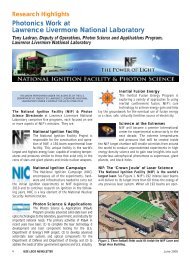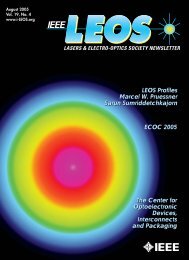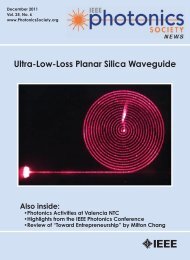High Performing Photodiodes For Demanding Applications
High Performing Photodiodes For Demanding Applications
High Performing Photodiodes For Demanding Applications
You also want an ePaper? Increase the reach of your titles
YUMPU automatically turns print PDFs into web optimized ePapers that Google loves.
20leos05.qxd 10/5/06 2:17 PM Page 29<strong>High</strong> <strong>Performing</strong> <strong>Photodiodes</strong><strong>For</strong> <strong>Demanding</strong> <strong>Applications</strong>Bruno Dion, Patrick Lepage and Nick BertoneAbstract:<strong>Demanding</strong> applications like Laser Range Finding,Proximity Fuses, Laser Designation, Smart Munitions andLaser Warning Systems all have the following in common:- Detection of short pulses of light; the more sensitivethe detector the better.- Ability to operate in harsh environments and over awide temperature range.- Requirement for a large dynamic range.In this paper we will examine how to design modulesand package these photodiodes for the above applications.In particular, we will focus on InGaAs APD’s for laserrange finding, as well as on an InGaAs PIN array for alaser-warning module.Introduction:Detecting laser pulses that are in the order of 10 to 20nsand which have peak powers from the nanowatt to themegawatt level require that both the detector and the supportingelectronics be high performance. When detectingthese pulses it should be noted that the detector rise is notvery fast when compared to what is required for Telecomapplications. If one were to use an off-the-shelf telecommodule to detect these pulses, one would find that theyCMC ELECTRONICS, MONTREAL, QCOEC, MONTREAL, QCwould not provide the best sensitivity and performance.In this paper we will explore detector modules fordemanding applications like Rx modules for laser rangefinding and laser warning systems. We will examine whatdetector parameters are important and why; furthermore,we will illustrate some of the key parameters and highlighttheir importance.Basic Properties of Detectors:The basic principle of a photo detector is to convert thelight signal to a current; furthermore, depending on theapplication, the detector can be optimized to obtain thebest performance. <strong>For</strong> example, building a device with athin junction results in very fast transit times but leads tolower QE, especially at the longer wavelengths and highercapacitance, which in turn leads to higher Rx noise. Also,depending on the application, using a detector with internalgain (Avalanche Photodiode) will lead to better overallsensitivity of the Rx module.The APD structure is designed to multiply the primaryphotoelectron, this is illustrated in figure 1, left. This multiplication,or gain, varies with the bias voltage and temperatureas illustrated in figure 1, right. In addition, smallchanges in the fabrication process, junction thickness orimplantation dose will result in a “Gain-Voltage” variationeven at the wafer level. Because of this, each APD willrequire a different voltage for the same gain, and in somecases the difference in the voltage required from APD toAPD can be many volts (Si APDs). This is not the case ifAnti-ReflectionCoatingIncident Light15−45°CResp vs Voltage for Various−25°C+25°C+50°C− ++++ + +N + Region++P RegionP + Region−ElectricFieldResponsivity 1069 nm129630 50 100 150 200 250 300 350 400 450 500VoltageFigure 1: Gain illustration and Gain vs. Voltage at various temperaturesOctober 2006 IEEE LEOS NEWSLETTER 29
20leos05.qxd 10/5/06 2:17 PM Page 30one were to use a PIN as the devices would all exhibit thesame responsivity for a given voltage; therefore if using anAPD or multiple APD’s which all share the same bias voltage– it is very important to minimize the Gain-Voltagevariation from APD to APD.I s RF_A V out = R*P O *R F,The increase in signal due to the gain is well understoodand if there were no noise associated with the increase ingain, operating the APD at high gains would always providebetter sensitivity; however, because of the excess noiseand the dark current, the highest gain is not always theoptimal gain. Paul Webb, Dr.R.J.McIntyre and J.Conradi did a verydetailed analysis of the properties ofAvalanche <strong>Photodiodes</strong> back in 1974 –in this section we will summarize just afew of the important parameters:P ODetector Noise(Dark, Bulk, Signal)Background Noise DominatesFigure 2: APD + Amplifier combinationQ747RX 25°C32.521.510.5+I a , Amplifier NoiseNoise Dominates if PINStep Familliy Signal's Background PwrQ vs Detector's Gain (M) - with Background Illumination00 10 20 30 40 50 60 70GainFigure 3: Optimal gain under different background conditionsDarkBackground1.00E-154.1E-098.2E-09Reiteratefor eachfamilyParametersExitReceiver Modules using APD’s:In the implications mentioned above, alarge field of view is usually requiredand, thus, a large area detector. Thisresults in large input capacitance for theamplifier and operation of the APDwhere the gain is limited by the opticalbackground power.Noise and Excess Noise:The above is due to the statistical natureof the APD gain. Not every electronholeundergoes the same multiplication,in fact the variation can be quite large.The result is excess noise that is approximatedby the following equation:F = kM + (1-k)(2-1/M)Where:k = ionization coefficient, average valuefor Si, 0.02, for InGaAs, 0.2-0.45.M = gainThis equation shows that the higherthe gain the higher the excess noise.Also, given that InGaAs has a muchResponsivity - 1064 nmResponsivities @ 1064 nm807060504030201000 100 200 300 400 500 600 700VoltageResponsivity - 1064 nmResponsivities @ 1064 nm353025201510500 50 100 150 200 250 300Voltage71 Deg 25 Deg 45 Deg 71 Deg 25 Deg 45 DegPremature Breakdown in ColdOperates Over Entire Temperature RangeFigure 4: Premature breakdown – left, Operation over entire temperature range – right.30 IEEE LEOS NEWSLETTER October 2006
20leos05.qxd 10/5/06 2:17 PM Page 31higher ionization coefficient, the APD’s will be noisier andcannot be operated at high gain even if they were able toreach high gain – most InGaAs APD’s have a maximumgain of 20.The total noise of an APD + amplifier combination isgiven by:< Noise Total> 2 = 2q[I ds + (P o R o F + P b R o F + I bd F)M 2 ]B +Ina 2Where:I ds = Bulk dark current which does not get multiplied.P o = Signal power to detectP b = Background radiationR o = Responsivity at unity gainI bd = Bulk dark current which is multiplied by the gainF = Excess noiseB = Bandwidth of operationI na = Amplifier noiseNote the following:- Using an APD makes sense when the amplifier noise is largerthan the PIN detector noise. <strong>For</strong> applications requiringthe detection of short pulses this will be the case, therefore,using an APD in these applications leads to better sensitivity.<strong>For</strong> example, a range finding customer was able to doublethe ranging distance by replacing the PIN with an APD.- It is very important to reduce the background as both theexcess noise and the gain multiply the background. Also,because of this, under background the optimal gain willbe lower than if there is no background. Figure 3 showsthe optimal gain with various background levels.Wide Temperature Range:<strong>For</strong> these applications the avalanche photon diode mustoperate over a wide temperature range, usually from –45 o Cto +125 o C. If the APD design structure and doping profileare not well defined the APD will breakdown at cold temperatures.This is illustrated in figure 4 below.<strong>For</strong> some applications a heater can be incorporated butfor others a heater cannot. If a heater is not used, thentremendous care must be taken to ensure that the APD willnot go into breakdown at cold temperatures.Receiver Modules using APD’s – FastRecovery:Under the right circumstances, Rx modules using APD’s providesolid advantages to PIN’s in terms of sensitivity. Also,with the right circuit design, the optimal gain can be automaticallydetermined given the temperature and background.Figure 5, left, shows a module designed and produced byCMC Electronics that has the following characteristics:Figure 5: APD module with custom circuit design and recovery from overload49.8 KW/cm 2 199 KW/cm 2 332 KW/cm 2 19940us/divFigure 6: Recovery time for APD only at different power levelsOctober 2006 IEEE LEOS NEWSLETTER 31
20leos05.qxd 10/5/06 2:17 PM Page 32MOREof 2)ClearAllOnOn1 2 100 mV/div On3On4+H 200 μs/div 792.000000 μs 0 T 136.8 mVFigure 7: Effect of recovery tail on APD’s gain- <strong>High</strong> voltage temperature compensation circuit to ensurethe APD is operating at the same gain no matter what thetemperature.- Automatic background control. The module can samplethe background and adjust the gain accordingly.- Overload protection with fast recovery from overload, andwithout ringing/after-pulsing.- Ability to survive large power pulses.While target distance and reflectivity varies, the returnpower may range from a nanowatt to nearly a kilowatt. Themodule should be able to recover very quickly when a highenergypulse falls on the detector. CMC has tested thismodule to 10MW/cm 2 where catastrophic power level wasreached. The module was able to withstand a couple ofpulses with that energy before it was damaged. Failures atthese power levels are caused by physical damage to theAPD structure while the amplifier survives. One methodthat would increase the APD’s survivability, is to spreadthe focused beam onto as large an area as possible, thus,reducing the probability of damaging the material. CMC iscurrently exploring new packages that will transform thefocused beam to a wider beam.Overload to the electronic circuit is addressed bydesigning a robust module as shown in Figure 5, left, thatlimits the current pulse and that quickly recovers from theoverload. Figure 5, right, shows an overload recovery froma pulse with peak power of 1W. The photo has a time scaleof 50ns per division. The output pulse (lower trace) showssmooth clamping of the low level, followed by a recoverywithout any ringing, plus a fast recovery APD.2(mV)Importance of APD on OverloadPerformance:In certain applications (Range finding, laser designationand laser warning), receiver module sensitivity is the mostimportant parameter once the speed of the module is set bythe laser pulse width that needs to be detected. In the applicationsthat we are interested in, the laserpulse that needs to be detected is usually 10to 20ns and, therefore, speed or rise time isnot a critical issue, but the following are:- <strong>High</strong> QE (Thicker junction leads to higherQE and slower response time)- Low capacitance for lower noise receiversn 0120 module performance.6kHz 1kHz- Low excess noise because of operation inhigh background environments.When the APD itself gets overloaded andtakes time to recover, the problem is a littlemore difficult to address. Figure 6 shows theresponse tail of an InGaAs APD with differenthigh power pulses. It is seen thatdepending on the power level, the recoverymay be quite long. CMC has determined theAPD related cause of this phenomenon, andwe are currently exploring APD designs todramatically improve the recovery time.The effect that is important for the APDto operate in this manner is the charge trapping. Thecharge trapping distorts the internal electrical field of theAPD and causes the gain to increase after the overloadpulse. A CW tone was injected in parallel with the overloadpulse to obtain figure 7. We observe a gain increase ofnearly 30% at 199kW/cm 2 after overload pulse when comparedto the gain in quiescent mode. The short-termimpact on gain can also be observed on noise and, in casesof severe overload, the tail may cause false pulse detection,which in turn causes system errors.−10 us 92 8610 us 110 109Laser off 79 78Summary:We have shown, in Figure 5, that it is possible to have thedesired performance from the optics and electronics forexposures to severe overload pulses. The performance fromthe electro-optics APD is achievable and we illustratedsome of the effects seen on various APDs from differentwafers and different sources. We showed measurementdemonstrating the undesirable short term effects on theAPD gain and noise after an overload. This highlights theimportance to have an APD with very low charge trapping.These modules can be produced and optimized for a 905nmpulsed laser diode, high power 1064nm lasers, 1550nm eye-safelaser range, or all of these wavelengths at once with widebanddetectors that can operate from 500nm to 1700nm or even higher.Operation temperature may range from –55 0 C to 110 0 C.Infrared solid-state detectors are ideal for many highendmilitary and aerospace applications. When designing amodule for a specific application, start with choosing thedetector that is best suited for the application or design onethat is optimal for the application. Once that is accomplished,design the circuit that allows for all the specificationsto be met. Since cost is always a factor do not overdesign the module to unnecessarily exceed all parameters ifit will only add cost. Finally, these modules, once qualified,will be used for a very-very long time and, therefore, it isimportant to minimize the design changes.32 IEEE LEOS NEWSLETTER October 2006




